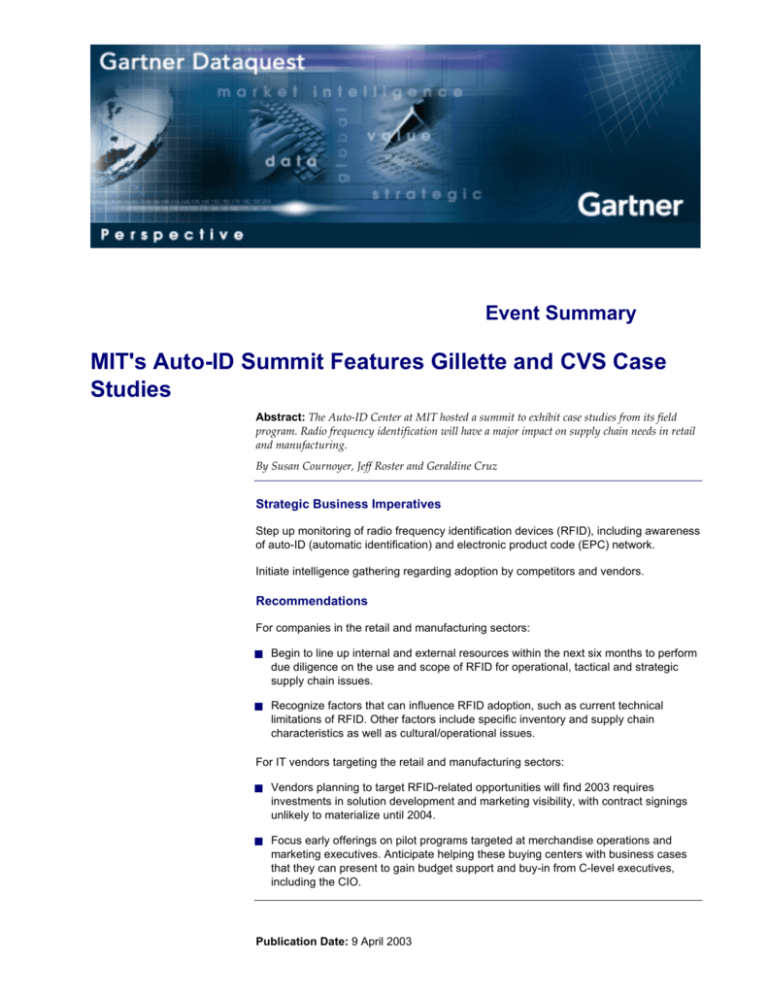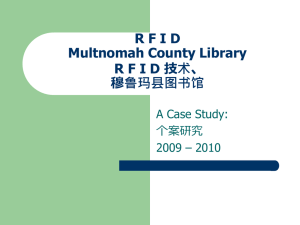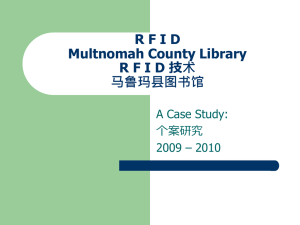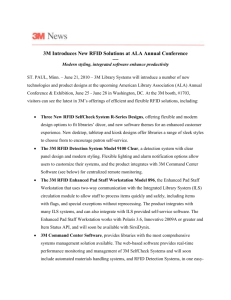
Event Summary
MIT's Auto-ID Summit Features Gillette and CVS Case
Studies
Abstract: The Auto-ID Center at MIT hosted a summit to exhibit case studies from its field
program. Radio frequency identification will have a major impact on supply chain needs in retail
and manufacturing.
By Susan Cournoyer, Jeff Roster and Geraldine Cruz
Strategic Business Imperatives
Step up monitoring of radio frequency identification devices (RFID), including awareness
of auto-ID (automatic identification) and electronic product code (EPC) network.
Initiate intelligence gathering regarding adoption by competitors and vendors.
Recommendations
For companies in the retail and manufacturing sectors:
■ Begin to line up internal and external resources within the next six months to perform
due diligence on the use and scope of RFID for operational, tactical and strategic
supply chain issues.
■ Recognize factors that can influence RFID adoption, such as current technical
limitations of RFID. Other factors include specific inventory and supply chain
characteristics as well as cultural/operational issues.
For IT vendors targeting the retail and manufacturing sectors:
■ Vendors planning to target RFID-related opportunities will find 2003 requires
investments in solution development and marketing visibility, with contract signings
unlikely to materialize until 2004.
■ Focus early offerings on pilot programs targeted at merchandise operations and
marketing executives. Anticipate helping these buying centers with business cases
that they can present to gain budget support and buy-in from C-level executives,
including the CIO.
Publication Date: 9 April 2003
2
MIT's Auto-ID Summit Features Gillette and CVS Case Studies
Applying RFID in the Lab, on the Pallet and on the Retail Shelf
The Auto-ID Center at MIT hosted an Analyst Summit on 6 February 2003
to discuss adoption of RFID and the (EPC network) supply chain
applications. The Summit provided three case studies and vendor
demonstrations of auto-ID. Auto-ID stands for automatic identification,
achieved through use of auto-ID technology and EPC tags affixed to
products. Although the system remains an area of study in MIT
laboratories, early trials in commercial environments have been launched.
This is not the first time applications using RFID have been applied
commercially, since the technology has already been in use for tollbooth
payments and pay-at-the-pump applications developed by petroleum
companies. One of the largest deployments is in livestock trading. There is
a range of vertical market applications and IT vendors that are either
tracking or investing in RFID research. The work of the Auto-ID Center
occurs in the context of an emerging market for applying the technology to
supply chain challenges.
RFID has captured the imagination of the Auto-ID Center researchers,
many key stakeholders in major retailers and manufacturers, and vendors
introducing auto-ID offerings. Widespread acceptance will hinge on
identifying and achieving business benefits. Anticipated benefits will
differ according to where a company fits in the supply chain, but auto-ID
supporters target the following list of supply chain improvements:
■
Improved stock replenishment on store shelves
■
Reduction of fraud and theft in the supply chain
■
Better inventory management along the length of the supply chain
Auto-ID supporters contend that although it is hard to quantify these
benefits, they will become obvious through pilots and through increased
and reciprocal adoption of the EPC network throughout supply chains.
Auto-ID Center Advocates Common Framework
The course from research and development to practical application for
RFID has taken decades, but most recently the story focuses on rapidly
accelerating efforts to apply RFID to business challenges. Although the
technology has been around for decades, costs and unresolved technical
challenges limited the practical applications of RFID to supply chain
challenges.
In the late 1990s, however, as the bar code marked its twenty-fifth
anniversary, members of the Universal Code Council decided to revisit the
potential of RFID technology for supply chain improvements. Procter &
Gamble, Gillette and Wal-Mart founded the Auto-ID Center at MIT in
1999. The center has worked to serve as a focal point of auto-ID research.
The center's earliest priorities focused on identifying potential
stakeholders in the global supply chain and defining critical elements of a
commercialized system.
2003 Gartner, Inc. and/or its Affiliates. All Rights Reserved.
9 April 2003
3
Five Proposed Elements of Auto-ID Network
The Auto-ID Center at MIT has identified five elements that it believes are
required to create a shared and potentially global EPC network to identify
and track products as they move through the global supply chain (see
Table 1). The Auto-ID Center works with its members to advocate for this
model of the commercial application of RFID technology to supply chain
challenges.
Table 1
Five Elements of Shared Auto-ID Network
Element
Description
EPC
Next generation of product identification similar to the UPC or bar code.
ID System
Radio frequency tags, ideally in the cost range of no more than a couple of cents, to be
applied during the manufacturing process, used in conjunction with Readers located in
plants, warehouses, stores, and shelves. The readers locate the EPCs of nearby tags and
pass the EPCs to a computer or local application.
Object Name Service (ONS)
The ONS tells computer systems where to locate information on the Internet about any
object carrying an EPC, similar to the Internet's established domain name system.
Physical Markup Language
A new standard language for describing physical objects, based on extensible markup
language.
Savant
Software technology to manage and move information in a way that does not overload
established corporate and public networks by using distributed architecture, to act as the
nervous system of the new EPC network.
Source: Auto-ID Center at MIT
The Auto-ID Center acknowledges that progress has been made in certain
areas while other technical challenges remain. For instance, some
challenges still exist for using EPC tags for metal containers and containers
with liquid products.
The Auto-ID Center works with vendors and commercial enterprises to
identify and spur research to address remaining challenges. Most recently,
the center sponsored a field test with 11 end users to test the EPC network
model proposed by the Auto-ID Center.
Auto-ID Field Trials and Business Case Development
The Summit brought together auto-ID researchers with supply chain
decision makers from major companies and IT vendors to discuss auto-ID
offerings. CVS and Gillette presented information about pilot tests and
planned use of auto-ID in the retail and manufacturing sectors. In the MIT
labs, meanwhile, they continue to identify and tackle remaining technical
barriers and challenges to adoption. Finally, a network of IT vendors and
solution providers are working to commercialize solutions related to autoID, based on common elements identified by MIT.
©2003 Gartner, Inc. and/or its Affiliates. All Rights Reserved.
9 April 2003
4
MIT's Auto-ID Summit Features Gillette and CVS Case Studies
Gillette Applies EPC to Supply Chain
The value chain group within Gillette's marketing organization has taken
the lead in championing and piloting the use of auto-ID by the global
manufacturing company. Gillette notes that it is looking to auto-ID to help
solve the No. 1 complaint to its toll-free customer number, which is that
customers cannot find specific Gillette products on the shelf at the retail
stores where they shop.
Gillette was a founding partner of the Auto-ID Center. In January 2003,
Gillette announced its intention to purchase up to 500 million EPC-enabled
tags from Alien Technology, for tags priced at less than 10 cents each.
Gillette identifies low cost EPC tags as a critical prerequisite for practical
application of the technology.
Gillette is planning field tests of auto-ID, targeting projects with two retail
partners: Wal-Mart in the United States and Tesco in the United Kingdom.
The pilots focus on the use of intelligent shelving to prevent out-of-stock
situations for Gillette grooming products. The earliest stage of the field test
is using Gillette's Fort Devens, Massachusetts Pack and Distribution
Center where RFID tags and readers are being used to track and verify
Venus cases and pallets from assembly to order loading. Priorities for 2003
include reviewing and sharing data from the pilot with supply chain
partners to evaluate next steps in adoption.
CVS Auto-ID Plan Targets Rx for Pharmacy
Inventory
CVS joined the Auto-ID Center in 2002. The stakeholder for auto-ID at
CVS is Jack DeAlmo, vice president of Inventory Management and
Replenishment. CVS recently selected a vendor to help with the pharmacy
supply chain pilot. CVS anticipates that the beta test of the pilot will be
complete by late 2003.
CVS' notes that its involvement in the Auto-ID Center and the use of EPC
technology is meant to address operational challenges in the company's
core business as a pharmacy healthcare provider. Although CVS sells
consumer packaged goods, 67.6 percent of the chain's revenue come from
the pharmacy operations. The inventory within the pharmacy supply
chain is more expensive than the general store operations and at the same
time is easily isolated, creating conditions conducive to an auto-ID pilot.
CVS emphasizes that the pharmacy supply chain creates specific
challenges to auto-ID adoption, particularly around privacy considerations
that could create a barrier to adoption if not recognized and handled
properly. Other challenges include inventory delivered largely as
components, such as containers of liquids and pills, that need assembly by
pharmacists into finished prescriptions.
2003 Gartner, Inc. and/or its Affiliates. All Rights Reserved.
9 April 2003
5
CVS recognizes that improving the experience of pharmacy customers,
which is the early focus of its pilot, can have business benefits because
pharmacy customers tend to visit CVS more frequently and make larger
purchases than general retail customers. CVS has formed an RFID
governance committee to oversee a customer-centric pilot focused on
tracking bottles and vials to speed prescription delivery to customers. The
committee includes the following members:
■
Senior legal counsel
■
CVS regulatory lead
■
Professional pharmacy representative
■
Pharmacy operations representative
■
Retail systems vice president
■
Finance vice president
■
Logistics vice president
Gartner Dataquest Perspective
Evaluating the use of RFID and auto-ID technology creates a challenge for
supply chain decision makers and IT vendors. The business case laid out
by the Auto-ID Center targets business benefits, but it is too early in the
adoption cycle to point to successful supply chain implementations.
Lessons From Case Studies
Recognizing that it is premature to expect proven solutions, case studies
(see Table 2) provide a preview of adoption patterns. Although case
studies cannot be used as a definitive guide to adoption, the following
patterns emerge:
■
Key buyers for using auto-ID technology and the EPC Network are not
just CIOs. In retail, the key people include merchandising and supply
chain executives. In manufacturing, the key people are warehousing,
supply chain, and customer service executives. The stakeholders all
have a supply chain perspective in common.
■
Business goals drive the adoption of RFID and auto-ID. Companies that
can articulate supply chain business problems and goals are the best
near-term prospects.
■
Logistics and transportation companies are conspicuous by their
absence. Presenters at the Auto-ID Summit mentioned that bringing
transportation companies into the fold remains a challenge.
©2003 Gartner, Inc. and/or its Affiliates. All Rights Reserved.
9 April 2003
6
MIT's Auto-ID Summit Features Gillette and CVS Case Studies
Table 2
Summary of RFID Plans at Gillette and CVS
Company
Buying Center
Pilot
Business Goals of Pilot
Usage of IT vendors
Gillette
Vice president of
auto-ID and
product
availability
within Gillette's
marketing
organization
Field tests focus on the use of
intelligent shelving to prevent outof-stock situations for Gillette
grooming products, verifying
system performance and accuracy
within Gillette's supply-chain
environment
Prevent out-of-stock;
Improve customer
satisfaction and loyalty
through improved product
availability;
Decrease lost sales;
Reduce loss within supply
chain
Announcement of plans to
buy up to 500 million RFID
tags from Alien
Technology
CVS
Vice president of
inventory
management
and
replenishment,
responsible for
merchandise
operations
CVS has formed an RFID
governance committee to oversee a
customer-centric pilot that focuses
on tracking bottles and vials to
speed prescription delivery to
customers
Gain clear perspective on
opportunities to improve
customer service;
Target increased delivery
speed to customer;
Enable CVS to understand
implications and
opportunities of tagging the
vial/prescription (evaluating
improved accuracy,
operating efficiencies, quality
improvements, and reduced
theft and diversion)
Interviewed and evaluated
potential consultants and
development partners;
Selected development
partner for pilot in 2003 to
tag bottles and vials
Source: Gartner Dataquest (March 2003)
Assessing Hype vs. Reality of RFID in the Retail
Supply Chain
RFID has probably created more hype in less time than any ever did in the
retail sector. The technology also is poised to have a major impact on the
consumer packaged goods manufacturing sector, which has been exposed
to RFID because of its participation in the retail supply chain.
In the retail sector, virtually every IT vendor (hardware, software and
services) has created an RFID story and every midsize to large retailer is
buzzing about its potential. However, this technology has been around for
several decades: It can accurately be described as an overnight success "10
years in the making."
Adoption Time Frame
There is little question that auto-ID technology will be both revolutionary
and transformational. At stake is the ability to solve the one problem that
every retailer wrestles with and has not been successful in eliminating;
that of running out of stock, and its disastrous impact on the bottom lines
of both manufacturers and retailers. The key to this technology is that it
will attack the problem with a very systematic approach and will offer
many additional benefits throughout the entire organization, thereby
making the large investment much more palatable for the organization.
The adoption process, however, will not come all at once. More likely it
will come in the following logical stages:
■
Short term (2004 to 2005) — Pallets/containers
2003 Gartner, Inc. and/or its Affiliates. All Rights Reserved.
9 April 2003
7
■
Midterm (2006 to 2008) — Cartons and high value items
■
Long term (2012 and beyond) — All items
RFID is shaping up to be one of the most significant disruptive
technologies ever in the retail supply chain. End-user organizations and
vendors making wrong choices could face significant hurdles in catching
up. It is very telling that Wal-Mart is a key retailer in the pilots. Wal-Mart
is not an organization with a reputation for adopting unproven leadingedge technology. Rather it will experiment with technology it sees great
value in and take great pains to minimize the downside risks of adoption.
Then when the company believes it has found a technology with great
value, it aggressively adopts and relentlessly squeezes every advantage
out of it. The fact that Wal-Mart is so aggressive in its involvement should
serve as a warning sign to all retailers about this technology's potential.
Gartner Dataquest Recommendations
Gartner Dataquest makes a number of recommendations to retailers,
manufacturers and IT services providers.
For Retailers
RFID is clearly a technology in which companies with world-class
reputation and supply chain excellence see great potential. End-user
organizations must understand the adoption patterns of critical
technology. As seen with customer relationship management, a significant
percentage of retailers will not put this technology through the rigorous
return-on-investment process that they would for a point-of-sale refresh
program. They will instead consider this technology so strategic that they
need to move ahead. It is important for every retailer to understand the
potential impact of this technology on their business and be prepared to
adopt at a faster rate than they have on other projects, if the technology
proves successful.
For Manufacturers
Despite the hype around RFID, the market is immature. Manufacturers
that invest too early in the technology could be burned by a high
investment in applications development, systems integration and
debugging a high price to pay given executive's insistence on
controlling cost.
However, these are not reasons for complacency. When the economy
improves and executives refocus on growing the business and forging
competitive advantages rather than stemming expenses IT executives
should be prepared to take support these new initiatives with new IT
strategies and the appropriate supporting portfolio. To the extent that
RFID poses significant benefits for the supply chain one of
manufacturers' top three key pain points IT leaders in manufacturing
companies must pay their due diligence in understanding the use and
scope of RFID to support their strategic, tactical and operational supplychain initiatives.
©2003 Gartner, Inc. and/or its Affiliates. All Rights Reserved.
9 April 2003
8
MIT's Auto-ID Summit Features Gillette and CVS Case Studies
Within the next six to 12 months, Type A manufacturers should fund a
band of entrepreneurial IT and business managers in developing business
cases for the use of RFID. Type B/C companies should assign IT staff to
monitor and track RFID vendors and service providers and the benefits
and challenges of RFID in user organizations.
For IT Services Providers
Plan for hybrid uses of RFID and traditional barcoding. Gartner Dataquest
anticipates that that RFID will not replace barcoding in 95 percent of
manufacturing companies in the next five years (0.8 probability).
Begin to create thought leadership pieces on the benefits and challenges of
RFID and develop models to help end users begin to quantify the benefits
(and costs) of RFID over barcoding technologies.
Assemble a team of alliance managers and solutions developers to assess
RFID technology maturity, vendor viability and the ability of RFID
product vendors in enhancing your supply-chain vision.
Key Issue
What impact will this event have on IT vendors or users?
This document has been published to the following Marketplace codes:
ITSV-WW-DP-0484
For More Information...
In North America and Latin America:
In Europe, the Middle East and Africa:
In Asia/Pacific:
In Japan:
Worldwide via gartner.com:
+1-203-316-1111
+44-1784-268819
+61-7-3405-2582
+81-3-3481-3670
www.gartner.com
Entire contents © 2003 Gartner, Inc. and/or its Affiliates. All rights reserved. Reproduction of this publication in any form
without prior written permission is forbidden. The information contained herein has been obtained from sources believed
to be reliable. Gartner disclaims all warranties as to the accuracy, completeness or adequacy of such information. Gartner
shall have no liability for errors, omissions or inadequacies in the information contained herein or for interpretations
thereof. The reader assumes sole responsibility for the selection of these materials to achieve its intended results. 114054









